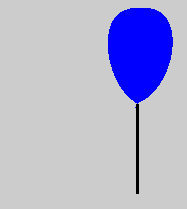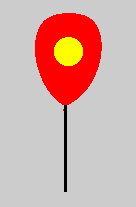 The image on the right shows loop structures in the Solar atmosphere.
From observations we have discovered that the loop structures
found in the solar corona are defined by a magnetic field.
The image on the right shows loop structures in the Solar atmosphere.
From observations we have discovered that the loop structures
found in the solar corona are defined by a magnetic field.
The convection stops at the photosphere. This kinetic energy can therefore not be carried directly up into the corona to heat it. So how does the sun carry the energy up into its atmosphere?
 The image on the right shows loop structures in the Solar atmosphere.
From observations we have discovered that the loop structures
found in the solar corona are defined by a magnetic field.
The image on the right shows loop structures in the Solar atmosphere.
From observations we have discovered that the loop structures
found in the solar corona are defined by a magnetic field.
The air around us is made up of neutral atoms and in physics we call this a neutral gas. As the temperature of the gas is increased the electrons of the atoms start to be stripped away from the nuclei creating a gas of ions, which we call a plasma. This plasma can carry currents and magnetic fields.
In the picture above there are magnetic fields coming out of the photosphere, rising up into the corona and then connecting back down through into the photosphere again. These form the loop structures. It is not the magnetic field that we see in the image, but the radiation from the plasma trapped by the magnetic field lines. The physics shows that plasma trapped on a magnetic field line stays on that field line. The magnetic field is therefore the link that we need to carry the energy from the convective motions up into the corona.
We all know that it is not possible to heat up a room mixing in cold air, for example by opening a window in winter! So, how does the magnetic field change this concept?
Some of the effects of a magnetic field line can be illustrated by a rubber band! A rubber band is an elastic string, which can be stretched, twisted and wound up. These basic characteristics are also true for a magnetic field and can be used to explain how the energy iscarried into the corona.

 Let's return to the rice pudding again and
take the model further. The physical
differences between the photosphere and
the corona are to some extend comparable to
the difference between the rice
pudding and the air just above it. In both cases
the density
changes enormously over the same short
distance where the temperature changes.
However, in the case of the Sun,
the temperature jumps from a lower to a higher value
as you go up from the dense photosphere to the less dense corona.
Let's return to the rice pudding again and
take the model further. The physical
differences between the photosphere and
the corona are to some extend comparable to
the difference between the rice
pudding and the air just above it. In both cases
the density
changes enormously over the same short
distance where the temperature changes.
However, in the case of the Sun,
the temperature jumps from a lower to a higher value
as you go up from the dense photosphere to the less dense corona.
The convective motions below the photosphere move the magnetic field around with it - first the end of the field line is dragged in one direction and then in another. Because the corona is much less dense than the photosphere, the magnetic field drags the coronal plasma along with it as the ends of the magnetic fieldline are being forced to move around by the convective motions in the photosphere.
You can get an idea of the effect by taking a balloon and using a rubber band as the string attached to it. Take the rubber band in your hand and move your hand around. If your hand is moving slowly from side to side then the balloon will follow the motions. However, if you make short fast movements with you hand then the string will move and the balloon will only tip from side to side.

|